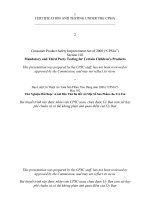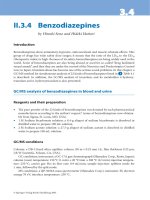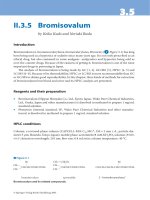Tài liệu Counseling and Psychotherapy theoriesin context and practice docx
Bạn đang xem bản rút gọn của tài liệu. Xem và tải ngay bản đầy đủ của tài liệu tại đây (4.79 MB, 554 trang )
john sommers-flanagan
rita sommers-flanagan
John Wiley & Sons, Inc.
counseling
and
Psychotherapy
theories
in
context
and
practice
SKILLS, STRATEGIES, AND TECHNIQUEScounseling
and
Psychotherapy
theories
in
context
and
practicejohn sommers-flanagan
rita sommers-flanagan
John Wiley & Sons, Inc.
counseling
and
Psychotherapy
theories
in
context
and
practice
SKILLS, STRATEGIES, AND TECHNIQUES
This book is printed on acid-free paper. øo
Copyright © 2004 by John Wiley & Sons, Inc. All rights reserved.
Published by John Wiley & Sons, Inc., Hoboken, New Jersey.
Published simultaneously in Canada.
No part of this publication may be reproduced, stored in a retrieval system or transmitted in any form or
by any means, electronic, mechanical, photocopying, recording, scanning or otherwise, except as
permitted under Section 107 or 108 of the 1976 United States Copyright Act, without either the prior
written permission of the Publisher, or authorization through payment of the appropriate per-copy fee to
the Copyright Clearance Center, Inc., 222 Rosewood Drive, Danvers, MA 01923, (978) 750-8400, fax
(978) 646-8600, or on the web at www.copyright.com. Requests to the Publisher for permission should be
addressed to the Permissions Department, John Wiley & Sons, Inc., 111 River Street, Hoboken, NJ
07030, (201) 748-6011, fax (201) 748-6008.
Limit of Liability/Disclaimer of Warranty: While the publisher and author have used their best efforts in
preparing this book, they make no representations or warranties with respect to the accuracy or complete-
ness of the contents of this book and specifically disclaim any implied warranties of merchantability or fit-
ness for a particular purpose. No warranty may be created or extended by sales representatives or written
sales materials. The advice and strategies contained herein may not be suitable for your situation. You
should consult with a professional where appropriate. Neither the publisher nor author shall be liable for
any loss of profit or any other commercial damages, including but not limited to special, incidental, conse-
quential, or other damages.
This publication is designed to provide accurate and authoritative information in regard to the subject
matter covered. It is sold with the understanding that the publisher is not engaged in rendering
professional services. If legal, accounting, medical, psychological or any other expert assistance is
required, the services of a competent professional person should be sought.
Designations used by companies to distinguish their products are often claimed as trademarks. In all in-
stances where John Wiley & Sons, Inc. is aware of a claim, the product names appear in initial capital or all
capital letters. Readers, however, should contact the appropriate companies for more complete information
regarding trademarks and registration.
For general information on our other products and services please contact our Customer Care Department
within the United States at (800) 762-2974, outside the United States at (317) 572-3993 or fax (317) 572-
4002.
Wiley also publishes its books in a variety of electronic formats. Some content that appears in print may
not be available in electronic books. For more information about Wiley products, visit our website at
www.Wiley.com.
Library of Congress Cataloging-in-Publication Data:
Sommers-Flanagan, John, 1957–
Counseling and psychotherapy theories in context and practice: Skills, strategies, and techniques /
John Sommers-Flanagan and Rita Sommers-Flanagan.
p. cm.
Includes bibliographical references and index.
ISBN 0-471-21105-2 (cloth)
1. Counseling. 2. Psychotherapy. I. Sommers-Flanagan, Rita, 1953– II. Title.
BF637.C6S69 2004
158Ј.3—dc21
2003053841
Printed in the United States of America.
10987654321
Contents
Preface xi
Contributors xvii
Chapter 1 Introduction to Psychotherapy and Counseling Theory
and Technique 1
Background and Overview 2
Historical Context 2
Definitions of Counseling and Psychotherapy 5
What Is a Theory? 9
Modern Therapy: Does It Work? 10
What Helps Clients: Common Factors or Specific Techniques? 13
Ethical Essentials 16
Emergence of Personal Theory 21
Our Biases 25
The Zeitgeist, the Ortgeist, and the Poltergeist 27
Concluding Comments 29
Student Review Assignments 29
Recommended Readings and Resources 30
Chapter 2 Psychoanalytic, Brief Analytic, Object Relations, and
Interpersonal Approaches 33
Biographical Information: Sigmund Freud 34
Historical Context 34
Psychoanalytic Theoretical Principles 37
Evolution and Development in Psychoanalytic Theory and Practice 44
The Practice of Psychoanalytic Therapy 52
Application: Case Examples 61
Therapy Outcomes Research 66
v
Concluding Comments 68
Student Review Assignments 70
Recommended Readings and Resources 72
Chapter 3 Individual Psychology: The Therapeutic Approach
of Alfred Adler 74
Biographical Information: Alfred Adler 75
Historical Context 75
Theoretical Principles 78
The Practice of Adlerian Therapy 89
Application: Case Example 101
Therapy Outcomes Research 106
Multicultural Perspectives 106
Concluding Comments 107
Student Review Assignments 107
Recommended Readings and Resources 109
Chapter 4 Jung and the Practice of Analytical
Psychotherapy 111
Biographical Information: Carl Jung 111
Historical Context 112
Theoretical Principles of Jungian Psychology 114
The Practice of Jungian Therapy 122
Application: Case Example 128
Therapy Outcomes Research 132
Multicultural Perspectives 132
Concluding Comments 134
Student Review Assignments 135
Recommended Readings and Resources 136
Chapter 5 Existential Theory and Therapy 138
Key Figures and Historical Context 139
Theoretical Principles 142
The Practice of Existential Therapy 153
Application: Case Example 163
Therapy Outcomes Research 164
Multicultural Perspectives 168
Concluding Comments 168
Student Review Assignments 169
Recommended Readings and Resources 172
vi Contents
Chapter 6 Carl Rogers: Person-Centered Theory and Therapy 174
Biographical Information: Carl Rogers 175
Historical Context 175
Theoretical Principles 179
The Practice of Person-Centered Therapy 186
Specific Therapy Techniques 190
Application: Case Example 198
Therapy Outcomes Research 205
Multicultural Perspectives 208
Concluding Comments 210
Student Review Assignments 210
Recommended Readings and Resources 212
Chapter 7 Behavioral Theory and Therapy 214
Historical Context 215
Theoretical Principles 219
The Practice of Behavior Therapy 225
Application: Case Example 243
Therapy Outcomes Research 248
Multicultural Perspectives 250
Concluding Comments 251
Student Review Assignments 253
Recommended Readings and Resources 255
Chapter 8 Cognitive Theory and Therapy 258
Forms of Cognitive Theory and Therapy 259
Theoretical Principles 264
The Practice of Cognitive Therapy 271
Application: Case Example 283
Therapy Outcomes Research 289
Multicultural Perspectives 290
Concluding Comments 291
Student Review Assignments 293
Recommended Readings and Resources 295
Chapter 9 Choice Theory and the New Reality Therapy 297
Biographical Information: William Glasser 297
Historical Context 298
Theoretical Principles 299
Contents vii
The Practice of Reality Therapy 311
Application: Case Example 317
More Reality Therapy Techniques 324
Therapy Outcomes Research 328
Multicultural Perspectives 328
Concluding Comments 329
Student Review Assignments 330
Recommended Readings and Resources 332
Chapter 10 Feminist Theory and Therapy 334
Key Figures and Historical Context in Feminist Therapy 334
Theoretical Principles of Feminist Theory and Therapy 336
The Practice of Feminist Therapy 343
Application: Case Example 350
Therapy Outcomes Research 353
Multicultural Perspectives 358
Concluding Comments 358
Student Review Assignments 360
Recommended Readings and Resources 361
Chapter 11 Constructivist Theory and Therapy 363
Biographical Information and Historical Context 364
Theoretical Principles of Constructive Therapy 370
The Practice of Constructive Therapy 374
Application: Case Example 390
Therapy Outcomes Research 392
Multicultural Perspectives 393
Concluding Comments 397
Student Review Assignments 397
Recommended Readings and Resources 399
Chapter 12 Multicultural and Non-Western Theories 401
Historical Context and Important Contributors 402
Theoretical Principles 407
The Practice of Multicultural Counseling 413
Application: Case Example 420
Non-Western Theories and Techniques 427
Therapy Outcomes Research 433
Concluding Comments 433
Student Review Assignments 434
Recommended Readings and Resources 436
viii Contents
Chapter 13 Integrative Theories of Counseling and
Psychotherapy 438
Foundations of Theoretical Diversity and Integration 439
Historical and Theoretical Trends in Counseling and Psychotherapy
Integration 442
The Practice of Specific Eclectic or Integrative Therapies 447
Concluding Comments 466
Student Review Assignments 469
Recommended Readings and Resources 470
References 473
Author Index 511
Subject Index 521
About the Authors 529
Contents ix
One morning, long ago, John woke up and decided he wanted to write a book on theo-
ries and techniques in counseling and psychotherapy. He thought, “Of all the classes I
teach, I love teaching theories and techniques best, so I should write a textbook.”
John then began using a cognitive self-instructional problem-solving strategy (see
Chapter 8). He identified the problems associated with existing theories and techniques
textbooks and formulated possible solutions. John decided, like any smart solution-
focused therapist, that talking about problems associated with other texts was a poor use
of his time (see Chapter 11). So instead he constructed a reality wherein his new textbook
was greeted with instructor satisfaction, student interest, and personal fulfillment.
Because of her uncanny powers of observation (an important nonspecific factor in
psychotherapy outcome—see Chapter 1), Rita noticed John’s positive construction of
reality and associated writing frenzy. She tried to help him deconstruct his perspective
by asking, “John, what are you doing?” Upon hearing his answer, she moaned, “Are
you crazy? That’s a huge project. And, I might add, there are quite a few theories books
out there already. Besides, I’d like to spend a little quality family time together in the
coming years. After all, what is life really about, anyway?” (See Chapter 5 for help un-
derstanding this existential crisis.)
Eventually, by appealing to Rita’s strong ethical standards, John got his way. Rita
came to believe she could weave in her feminist and multicultural sensitivities to help
this book fill an important niche in the somewhat crowded theories textbook market.
Overall, we’ve done our best to produce a book that’s fun, interesting, interactive,
practical, cutting-edge, and provocative, and that gives new life to theories of counsel-
ing and psychotherapy. Students who reviewed the manuscript especially enjoyed the
bursts of innovation and creativity we tried to integrate into the text. In particular, they
loved the imaginary group therapy session with many great historical and contempo-
rary theoretical characters included at the end of Chapter 13. We hope innovation and
creativity are two qualities that characterize our approach to writing this book.
WRITING STYLE AND OVERALL APPROACH
Students sometimes claim that counseling and psychotherapy theories textbooks are,
in fact, an excellent treatment for insomnia. To address this issue, we tried to write this
book with great enthusiasm. To help keep students awake and alert, we’ve incorporated
basic adult learning principles and used a more informal writing style. Each chapter
• Is written in a student-friendly and engaging style
• Includes numerous interactive questions for reflection
xi
• Integrates short pieces written by active scholars and practitioners (other than
ourselves) to increase the diversity of voice and perspective
Many times we’ve asked ourselves, why should college and university instructors
adopt this book? One way we addressed this question was to ask students and profes-
sors to review the evolving manuscript and provide suggestions. Generally, students
asked that we emphasize a practical approach to learning about theories. Conse-
quently, each chapter includes sections on how to prepare for doing therapy from a par-
ticular theoretical perspective and how to prepare clients to participate in such therapy.
In contrast, professors were more likely to suggest that we briefly and articulately de-
scribe the history and context underlying each therapeutic approach. These sugges-
tions led us to consult a variety of historical works so we could, whenever possible, ac-
curately paint the historical and cultural background accompanying each approach.
TEXTBOOK HIGHLIGHTS AND PEDAGOGICAL TOOLS
While we were writing this text, Rita was appointed Director of the Women’s Studies
Program at the University of Montana. She has since spent many long nights contem-
plating the true meaning of the word pedagogy—which caused us to integrate an ex-
ceptional array of diverse pedagogical tools into this text.
Contextual emphasis. In every chapter, we have contextualized the theories, so you
get exposure to the dramatic historical influences on the thinker(s), researcher(s), and
practitioner(s) who created or contributed to the theoretical orientation under discus-
sion.
Practitioner Commentary. To increase the quality of this book and provide a broader
and deeper perspective for each theory, we shamelessly bothered our friends, col-
leagues, and noted experts in the field—both current practitioners and academic
types—for their opinions and insights into psychotherapy theory and technique. We
asked them to write as if they were talking with a small group of graduate students
about theories and techniques of counseling and psychotherapy. The results were every-
thing we had hoped for. From the provocative contributions of the renowned Italian
constructivist Giorgio Nardone, to the crisp and scholarly essay by Judith Beck on why
she is a cognitive therapist, these practitioner commentaries educate and inspire. The
full list of contributors, along with their biographical information, follows this preface.
Ethical Highlights and Multicultural Perspectives. Rather than artificially separating
and compartmentalizing ethical and cultural issues and then relegating them to sepa-
rate chapters, we’ve woven an exploration of these issues into every chapter. Our hope
is to facilitate more integrated thinking about ethical and cultural issues—and perhaps
stimulate a few lively class discussions along the way. Every chapter includes a “Multi-
cultural Perspectives” section and boxed material titled “Ethical Highlights.”
Putting It in Practice. To help prepare young therapists for a real world where pres-
sure from managed mental health care requires an emphasis on practical and concrete
application of theoretical principles, this text strongly emphasizes technical applica-
tions of each theory. Emphasizing techniques was one of our main goals in writing this
book because we recognize that novice mental health and human service providers are
expected to quickly know the pragmatics of providing treatment to clients in need.
Every chapter includes boxed material titled “Putting It in Practice.”
xii Preface
TEXTBOOK ORGANIZATION AND OVERVIEW
This text includes 13 chapters covering 12 different theories and approaches to coun-
seling and psychotherapy.
In Chapter 1, we provide an overview and foundation for studying the great theories
of therapy. The chapter includes information about the history, empirical research, and
ethical principles that form a foundation for the practice of counseling and psycho-
therapy. Additionally, we include information on how students can explore their own per-
sonal theory and how broad social and cultural factors, including the Zeitgeist, Ortgeist,
and Poltergeist, can shape and form how we think about various therapeutic approaches.
Chapters 2–13 focus on specific theoretical and therapeutic approaches. These the-
ories and approaches include
Chapter 2: Psychoanalytic, brief analytic, object relations, and interpersonal ap-
proaches
Chapter 3: Individual psychology: the therapeutic approach of Alfred Adler
Chapter 4: Jung and the practice of analytical psychotherapy
Chapter 5: Existential theory and therapy
Chapter 6: Carl Rogers: person-centered theory and therapy
Chapter 7: Behavioral theory and therapy
Chapter 8: Cognitive theory and therapy
Chapter 9: Choice theory and the new reality therapy
Chapter 10: Feminist theory and therapy
Chapter 11: Constructivist theory and therapy
Chapter 12: Multicultural and non-Western theories
Chapter 13: Integrative theories of counseling and psychotherapy
Every text has limited scope, and this text is no exception. The first and biggest omis-
sion from our list of theories is family systems theory. To be honest, we left it out pri-
marily because every psychology and counseling program we know has an entire course
on family systems theory. Therefore, we rationalized that it might be more important to
devote time to covering less commonly studied theoretical perspectives, such as Jun-
gian and constructivist theory, both of which usually receive little specific coverage in
most graduate programs. Additionally, we only obliquely address interpersonal theory
and the impressive contributions of Harry Stack Sullivan within the context of psy-
choanalytic theory (Chapter 2) and eclectic/integrational theory (Chapter 13).
Chapters 2–13 follow, more or less, a consistent format. In addition to periodic
“Questions for Reflection” and “Putting It in Practice” boxes, major chapter sections
include
• An introductory statement
• Historical context and biographical information
• Theoretical principles
• A section on the practice of each theoretical approach, which includes informa-
tion on self-preparation, client preparation, assessment strategies, and specific
techniques
Preface xiii
• An extended case example
• Therapy outcomes research
• Multicultural perspectives
• Ethical highlights
• Practitioner commentary
• Concluding comments
• Student review assignments
• Recommended readings and resources
THE USE OF CASE EXAMPLES
As we discuss briefly in Chapter 2, using case examples to illustrate theoretical prin-
ciples and therapy techniques can be problematic. Although a well-described case is
unarguably an excellent teaching tool, it is also just one case and obviously not repre-
sentative or illustrative of the magnificent diversity inherent in conducting therapy with
individuals.
Consequently, we decided against the format of providing a single case to represent
the plurality of people and problems that therapists face in the real world. Instead, al-
though we still use extended case examples to illustrate therapeutic procedures and pro-
cess, in an effort to individualize therapy to fit specific clients and problems, we provide
different case examples for each chapter. We think this approach is a better reflection
of competent and ethical practice than other pedagogical alternatives.
AN EMPHASIS ON RELEVANCE
We don’t really like admitting this, but as instructors, we’ve occasionally had graduate
students sincerely confide to us that adding to their knowledge of psychotherapy theo-
ries doesn’t seem very relevant in their day-to-day professional lives. “After all,” they
complain, “most of the theorists are dead, most of the theories seem dead, and it’s hard
to imagine using free association, dream analysis, Pavlovian conditioning, and other
theory-derived techniques in our professional settings.”
The point of studying the concepts in this book is not always direct application, al-
though we hope application is not far away. Our hope is that you take the time to un-
derstand the history and diversity in theories of why humans suffer psychologically and
what will bring about change, relief, growth, development, and even self-actualization.
This book is only a small slice of that history and diversity, but we cover the majority of
the theories from the turn of the century forward that have developed within Western
European culture. We admittedly cover many theories you won’t agree with, and many
you could use more often. But trust us. It is far better to know and then reject a given
approach than to have no exposure to it at all. Surveying and sampling each theory in
this text will help you develop your own personal approach and theory of counseling
and psychotherapy.
Speaking of sampling theories, one way to approach learning theories is a strategy
that we heartily endorse called the “swallow it whole” approach. This approach re-
quires jumping head first into each theory in each chapter. When you come to the per-
son-centered chapter, pretend you’ve experienced a person-centered conversion, and
then, when you move on to behavior therapy, change your persona. Use the psycho-
xiv Preface
logical technique of being “as if” (see Chapters 3 and 11) to get into the heads and
hearts of those who really believe the stuff of the theory, and then try to enact it. Pre-
tend you are, in fact, Jean Miller Baker, or Carl Rogers, or (if you have no rules about
swearing at your house) Albert Ellis. Suspend judgment and give the whole theory, or
at least some key techniques, a try from the inside out. Try your best to see how you
could tackle a given problem or irritation in your life through the strategies implied in
the theory.
Another approach to learning theories, for the more oppositional among us, is to
learn a theory well enough to convincingly and intelligently refute it. This will require
knowing a number of theories, and knowing your own worldview pretty well. You can’t
just say “I don’t believe in object relations theory and therapy because of its link to
Freud, and Freud was sexist.” Only undergraduates with undeclared majors can get
away with this. Instead, you need to understand a theory well enough to know where it
breaks down. Try this: “Behavioral theory can be used effectively to change troubling
behaviors, but I find I am more existential in orientation, preferring to work from the
perspective of human freedom, meaning-making, and responsibility.”
LEARNING IN THE FUTURE
In our therapy work with individuals, couples, and groups as well as in our teaching,
we’ve discovered and rediscovered the obvious truth that learning continues long after
the therapeutic and teaching activities end. To facilitate continued student develop-
ment into the future we’ve included periodic “Questions for Reflection” in each chap-
ter and end each chapter with a series of student review assignments. These questions
and review assignments are designed to promote and provoke a lingering of student
thinking and interest even after the text has been set aside.
Finally, we should mention that adopting this text provides access to an on-line In-
structor’s Manual to assist professors in teaching their theories courses. The Instruc-
tor’s Manual includes sample syllabi geared toward teaching theories from the psy-
chology and counseling fields (including APA and CACREP-based objectives), chapter
outlines, additional lecture topics, classroom activities and suggested assignments, pro-
cedures for conducting small-group oral examinations, and a test bank with multiple-
choice and short-answer test items. Additionally, you may contact the authors for con-
sultation or to provide feedback at
ACKNOWLEDGMENTS
Many colleagues and friends helped this book come into being. In addition to the
names you’ll see in the “Contributors” section, we offer our special thanks to Bernie
Balleweg, Ph.D., and Marianne Spitzform, Ph.D.
Our daughters, Rylee Sommers-Flanagan and Chelsea Elander, have voluntarily
(but not always quietly) allowed us to expose them to many theoretical experimenta-
tions and conversations. They’ve been most patient and supportive.
Our editor, Tracey Belmont, and the other professionals at John Wiley and Sons
continue to be inspirational, helpful, trustworthy, and affirming.
This book would not exist if not for our many students over the years. Your laugh-
ter, your learning, and your feedback inspire us to keep on thinking, learning, and
writing.
Preface xv
The following mental health professionals contributed Practitioner Commentaries,
Ethical Highlights, or Multicultural Perspectives to this textbook. Their written con-
tributions greatly enhanced, deepened, and broadened this book’s story of theory and
therapy. Their contributions also enriched the learning process for us, and we thank
them for their insight and wisdom.
Judith Beck, Ph.D., is the director of the Beck Institute for Cognitive Therapy and
Research in Philadelphia and clinical associate professor of psychology in psychia-
try at the University of Pennsylvania. She is the author of Cognitive Therapy: Basics
and Beyond (Guilford Press) and the forthcoming book Cognitive Therapy for Chal-
lenging Patients (Guilford Press). Dr. Beck is a distinguished founding fellow and
president of the Academy of Cognitive Therapy. Her Practitioner Commentary,
“Why I am a Cognitive Therapist,” is featured in Chapter 8 (cognitive therapy).
L. Sherilyn Cormier, Ph.D., is a professor in the Department of Counseling, Reha-
bilitation Counseling, and Counseling Psychology at West Virginia University. In
this role she specializes in teaching and supervising master’s and doctoral students.
She is the author or coauthor of several textbooks related to counseling practice, in-
cluding Interviewing Strategies for Helpers (Brooks/Cole). She does a lot of training
related to clinical supervision issues. She experiences “flow” when engaging with
students, supervisees, bike riding, walking, boating, and reading! Her Practitioner
Commentary, “Four Cornerstones of Being a Therapist,” is featured in Chapter 6
(person-centered therapy).
Suzanne Comingo Griffith, Ph.D., is professor of counseling and psychological pro-
fessions at the University of Wisconsin, Superior. She publishes in the area of
women’s issues, especially the intersection of race, gender, and class, and actively
works to improve the psychological climate. Her Practitioner Profile, “The Personal
is Political,” is featured in Chapter 10 (feminist therapy).
Daniel Eckstein, Ph.D., is president of Encouraging Leadership Inc. in Scottsdale,
Arizona. He is also director of organization development for the Adler School of
Professional psychology in Toronto and adjunct faculty in counseling psychology
for Capella University in Minneapolis. Dr. Eckstein is the author of eleven books,
including Psychological Fingerprints: Lifestyle Assessment and Intervention, Leader-
ship by Encouragement, and Raising Respectful Kids in a Rude World. His web page
is www
.encouragingleadership.com. His Practitioner Commentary, “Encourage-
ment and Adlerian Psychology,” is featured in Chapter 3 (Adlerian therapy).
Claudette Kulkarni is a psychotherapist in private practice and at Persad Center (a
mental health agency serving the “sexual minority” and HIV/AIDS communities
xvii
and their families), in Pittsburgh, Pennsylvania. She is the author of Lesbians and
Lesbianisms: A Post-Jungian Perspective, and “Radicalizing Jungian Theory” in
Contemporary Perspectives on Psychotherapy and Homosexualities. She is a con-
tributing editor to The Round Table Review. Kulkarni’s Multicultural Perspective,
“On Being a Lesbian Jungian,” is featured in Chapter 4 (Jungian therapy).
Kurt L. Kraus, Ed.D., is an associate professor in the Department of Counseling at
Shippensburg University of Pennsylvania. His professional interests include the ap-
plication of existential and phenomenological perspectives to counseling, counselor
education, clinical supervision, and research. Kurt likes to play outdoors. He and his
family live in Carlisle, Pennsylvania. His Practitioner Commentaries, “Your Emerg-
ing Personal Theory” and “Existential Musings,” are featured in Chapter 1 (an in-
troduction) and Chapter 5 (existential therapy).
Mark Kuras, Ph.D., is a clinical psychologist and a Jungian analyst. He is on faculty
at the College of Physicians and Surgeons at Columbia University Medical School
and at the C.G. Jung Institute of New York. He is an associate Editor on the Journal
of Jungian Theory and Practice. He maintains a private practice in New York City.
His Practitioner Commentary, “The Jungian Dynamic Unconscious,” is featured in
Chapter 4 (Jungian therapy).
Ellen Hawley McWhirter, Ph.D., obtained her doctorate from Arizona State Uni-
versity. She is an associate professor of counseling psychology at the University of
Oregon. Her teaching includes practicum and vocational counseling, and her schol-
arship focuses on empowerment and the vocational development of adolescents of
color. She is coauthor of Youth at Risk, Pacific Grove, CA: Brooks/Cole. Her Prac-
titioner Commentary, “Experience Your Theory,” is featured in Chapter 1 (an intro-
duction).
Scott T. Meier, Ph.D., is professor and codirector of training of the Program in
Counseling/School Psychology, Department of Counseling, School, and Educa-
tional Psychology, State University of New York at Buffalo. Meier is the author or
coauthor of four books, including The Elements of Counseling (Brooks/Cole), and
40 journal articles. He is a licensed psychologist who received his Ph.D. in counsel-
ing psychology from Southern Illinois University, Carbondale, in 1984. His Practi-
tioner Commentary—“The Future (of Behavior Therapy) Is Feedback!”—is fea-
tured in Chapter 7 (behavior therapy).
Kurt D. Michael, Ph.D., is an assistant professor of psychology at Appalachian State
University and is in independent practice. He was trained at the University of Col-
orado, Boulder; Utah State University; and Duke University Medical Center, and
he holds a Ph.D. in clinical psychology. His Practitioner Commentary, “A Winding
(and Serendipitous) Road to Integration,” is featured in Chapter 13 (Integrative
Therapy).
Professor Giorgio Nardone, Ph.D., is director of the Centro di Terapia Strategica
(Center for Strategic Therapy), the only official representative for Italy of Mental
Research Institute of Palo Alto, California, and director of the Postgraduate School
of Brief Strategic Therapy in Arezzo. He is also professor of brief psychotherapy at
the Postgraduate School of Clinical Psychology, University of Siena, Italy. With a
Ph.D. in educational science from the University of Siena, he holds the title of spe-
cialist in clinical psychology at the School of Medicine, University of Siena. He has
xviii Contributors
published many articles and 14 books translated in many foreign languages. His sys-
tematic and effective models for treating phobic and obsessive disorders and eating
disorders are followed by many psychotherapists all around the world. Nardone’s
books include The Art of Change: Strategic Therapy and Hypnotherapy Without
Trance (Jossey-Bass), Brief Strategic Solution-Oriented Therapy of Phobic and Ob-
sessive Disorders (Jason Aronson), and Brief Strategic Therapy (Jason Aronson). His
Putting It in Practice, “Applying Strategic-Constructivist Techniques to Yourself,”
and his Ethical Highlight, “Constructive Ethical Principles,” appear in Chapter 11
(Constructive Therapy).
Brent Richardson, Ph.D., is an assistant professor in counseling at Xavier University
in Cincinnati. He is the author of Working with Challenging Youth (Brunner/Rout-
ledge). His Ethical Highlight, “Pay Attention to What You Pay Attention To,” is fea-
tured in Chapter 12 (Multicultural Theory).
Natalie Rogers, Ph.D., is a pioneer in expressive arts therapy. She is an author, artist,
psychotherapist, and group facilitator. She founded the Person-Centered Expressive
Therapy Institute, California, and has taken this training to Europe, Russia, Latin
America, and Japan. She is author of Emerging Woman (1980) and The Creative
Connection: Expressive Arts as Healing (1993). She is the daughter of the humanis-
tic psychologist Carl Rogers. An interview of her is featured in Chapter 6 (person-
centered therapy).
Felix Salomon, Ph.D., received his doctorate in clinical psychology from Long Island
University, Brooklyn, New York. During the past 25 years, Dr. Salomon cofounded
and was the first president of the Phoenix Psychoanalytic Study Group and chaired
the Arizona State Psychological Association Ethics Committee. Currently, Dr. Sa-
lomon is in independent-private practice in Phoenix, Arizona. His Ethical Highlight,
“Maintaining a Safe Container,” is featured in Chapter 2 (psychoanalytic theory).
David Scherer, Ph.D. (Clinical Psychology, University of Virginia), is an associate
professor of counseling and an assistant professor of psychiatry at the University of
New Mexico. He is a family systems theorist and specializes in research and inter-
ventions with children, adolescents, and families. His Practitioner Commentary,
“Integrational, Not Eclectic,” is featured in Chapter 13 (integrative therapy).
Susan Simonds, Ph.D., has her doctorate in clinical psychology from The Fielding
Institute, a master’s degree in creative arts therapy from Hahnemann University, and
a bachelor’s degree with distinction in Chinese language and literature. She is the au-
thor of Depression & Women: An Integrative Approach to Treatment (Springer, 2001)
and Bridging the Silence: Nonverbal Modalities in the Treatment of Childhood Sexual
Abuse (Norton, 1994). Her Practitioner Commentary, “Finding My Own Eclectic
Feminist Theory,” is featured in Chapter 10 (feminist therapy).
Marianne Spitzform, Ph.D., completed her training in clinical psychoanalysis with
the Colorado Center for Psychoanalytic Studies and received her doctorate in psy-
chology from the University of Montana. She is in private practice in Missoula,
Montana. Her Practitioner Commentary, “Why I Became a Psychoanalyst,” is fea-
tured in Chapter 2 (psychoanalytic therapy).
Tamara J. Suttle, M. Ed., is a licensed professional counselor in Castle Rock, Col-
orado, specializing in the gay, lesbian, bisexual, and transsexual communities. Her
Contributors xix
services include the use of interactive drama and games as well as traditional psycho-
therapy with individuals, couples, and groups in a variety of settings including con-
ferences, workshops, and retreats. Her Practitioner Commentary “Why Adlerian
Theory” is featured in Chapter 3 (individual psychology).
Luis A. Vargas, Ph.D., is an associate professor and director of the clinical psychol-
ogy predoctoral internship program in the Department of Psychiatry at the Univer-
sity of New Mexico School of Medicine. He has written many articles and several
books, including Working with Culture (San Francisco: Jossey-Bass) and Working
with Latino Youth (San Francisco: Jossey-Bass). His Practitioner Commentary, “Re-
flections of a Process-Oriented Contextualist,” is featured in Chapter 13 (multicul-
tural theory).
Robert E. Wubbolding, Ed.D., is professor emeritus at Xavier University, director of
training for the William Glasser Institute, and director of the Center for Reality
Therapy in Cincinnati. He has taught reality therapy from Korea to Kuwait and
from Singapore to Slovenia. Over the years, he has been a high school counselor, el-
ementary school counselor, and halfway house counselor for ex-offenders. He has
authored over 125 articles and essays, 17 book chapters, and 10 books—including
the most comprehensive book on reality therapy: Reality Therapy for the 21st Cen-
tury. His Practitioner Commentary, “The Interface Between Choice Theory and Re-
ality Therapy,” is featured in Chapter 9 (reality therapy).
Kazuo Yamashita, M.S.W., is an assistant professor at Kanasai University of Social
Welfare in Japan. His Multicultural Highlight, “My PCA Experience in Japan,” is
featured in Chapter 6 (person-centered therapy).
xx Contributors
counseling
and
Psychotherapy
theories
in
context
and
practice









